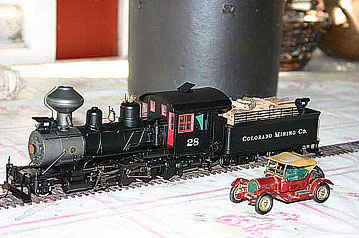More images













Finally after months venturing around the world my first of the planned two Bachmann Consolidations finally arrived. And I was very impressed of it on the first sight. And after the second sight I still am. Compared to H0-scale equipment it is huge. I have an AT&SF mountain in brass and the model I estimate comes close to same length as the new 2-8-0. But the difference is not in length it is in width and height, the Con is way bigger in those respects and I guess this one thing you have to keep in mind if you are planning on a layout. After rereading an article on a small layout with 0n30 equipment in mind I learn that a Bachmann Mogul is about the same length as a typical Pacific or a Mikado in H0-scale.
The model is impressive, not only in size, but also in detail and paint. Sitting on track it has the looks of a real thing and being used to look on images of a DRG&W Mudhen it looks like a cute duckling. From the start you can customize with the extra parts. A cowcatcher, straight stack, with extra piping, a extra pilot truck with solid wheels and you can make you model as a coal-, oil- or a wood burner with the parts included. Excellent!! The model is a gem, and you can spend some time with just staring the model, what may have looked odd in some images is gone when eye balling it live. It looks and feels like a real steamer, really. Makes you wonder how nice is her 1:20,3 scale sister really must look….

The #28 with a friend, a Stutz from Matchbox I got in 1960,s
I stick so long with the onion stack but transformed my # 28 into a wood burner, as a general idea of a future layout is a portion of a railroad which initially was an ore hauler but the ore business is about phase out while the trains haul more and more timber, as a sort of a mix of a logging railroader and a common carrier. By this configuration, it also reminds me of steamers back in my native Finland that still hosted wood burners to the very end of the steam. Even the most modern classes of steames featured engines that were wood burners, so the added “fence” and wood pile and the onion stack will remain. The pile also gives the tender a bit off balanced looks to the engine.
The size of this engine got me a little thinking, much of my earlier thoughts of in layout planning was confirmed. The larger scale narrow gauge designed to use a standard gauge track of a smaller scale will need have some adjudgements compared to a layout using same gauge in smaller scale. The larger width and even height means changes in layout design.
Some of other physical elements needs to be adapted as well, especially size of the buildings, highways, detail and vehicles you wish to include. This means you hardly can adopt a typical H0 track plan with out some adjudgements. Let’s say we have a typical 4’x 8´ track plan designed for H0-scale to keep the equipment acting and looking nice, we need some additional width for the layout for boarder curves. Also the wider equipment needs a bit of more space between two pararell tracks than in H0-scale, I guesstimate by now we have added a perhaps a extra foot or two to the width because the boarder curves and perhaps same amount to the length. Then we wish to not compress the scenes that much so we need to add a bit more. I guess we end up in the neighbourhood of 6’x12´layout to capture as much as possible of the earlier design. Well, you can dispose a few buildings so we can compress even more and I guess we might loose another foot or two. But we are still doing fine, as if we would transform the earlier layout to 0-scale standard gauge we should have needed to double the size of the original layout. So you can shrink a lot by using narrow gauge…
The prototype for the pattern is a such a railroad which terminated not that far from home, called DONJ, which also started as a local ore hauler and ended as a lengthy narrow gauge timber hauler until the trucking became more efficient into eh late 1960.s and the line was abandoned in 1970. A cool thing is that rail road did look close on inventions in USA and adapted to Swedish looks and designs, though they did order and receive one American engine a 0-6-2 tank which during the years lost its American looks by new boiler and cab and it was scrapped in the 1950.s. A small portion with the main yard and all the shop buildings and some 5 kilometres of track still remains as a preserved railroad, including the lines two remaining 0-6-6-0 Mallets. So what I do is Americanize a Swedish timber hauler that was under some influence of the railroads in America.
What is the issue here you may ask? I guess it is my initial reaction towards some of the things have been a “fact” in model railroading that you can take standard gauge track plan and run narrow gauge equipment on it on same space. To some extend this still holds true, as the narrow gauge equipment still stays on the track. But in order to look go it need some addition in both length and width with out getting a toy like look. Remember the most convincing layouts are the ones where the surroundings are dominating over the trains, but still keeping the trains as the stars of the show.